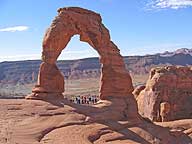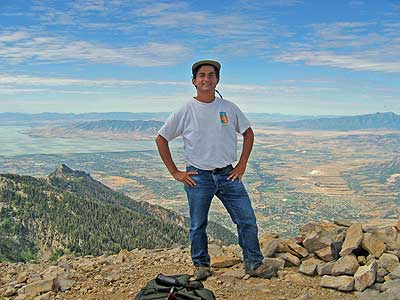 |
Adventures in Camping, Backpacking, and Canyoneering About This Site |
> Home
|
Deadly Hiking Mistakes | Terms of Use and Disclaimer | About the Author
Each page will describe the hike, often containing GPS coordinates (WGS84, listed in degrees and decimal minutes) on where to begin. Additional information on the length and difficulty of the hike (or running event) and how to prepare for the adventure is included. Because visitors will likely come from different directions, I suggest you use online search engines like Google or Yahoo! to plot driving instructions to the general area. Unlike some guidebooks written by expert, trailblazing hikers, I have prepared the trail descriptions and hiking or running times based on what the average hiker might experience, taking into account periodic stops to eat, rest, and socialize. Of course, hiking/running times will vary depending on ability, but I always found that if a hike said it would take 4 hours, it usually took me 5 or 6. It's much better to add time to your estimated travel than to get lost on a mountain without a headlamp. NEVER overestimate your abilities. Too many people have become victims because they thought they could forge that next stream or climb that peak only to find out that the water was way to swift and they didn't notice the slippery moss on that rocky outcropping. Bagging a peak is never better than losing your life because you didn't use more caution and commonsense. As with any hike, there is always the possibility of injury or risk of life; therefore, hikers should consider taking of the following precautions:
All too often, we hear of hikers going missing only to discover that some of their lack of preparation or mental awareness of their surroundings might have contributed to injury or death. However, novice backpackers are not the only ones to fall victim; experienced hikers also can get lost, become disoriented, and die due to overconfidence.To minimize unfortunate outcomes, you should avoid common mistakes to protect you and those who join you in the backcountry. For example, Summit Hypnosis ("A Dozen Ways to Die," Backpacker, October 2006, p. 76) is a condition where hikers become so fixated on reaching a goal that they let another factors (e.g., impeding adverse weather conditions, poor conditioning, etc.) cloud their judgement. In fact, this preoccupation can contribute to blindess about everything around you, including your companions' physical condition. When hiking in groups, stick together or have a way to communicate along the trail if others fail behind, and regroup to check on everyone. Two-way radios can help. All contents of this site are copyright (2006-2014) by Hiking in Utah. The information can be printed for personal use, but the contents (including text and pictures) cannot be copied, modified, reengineered, or published to any other Web site (commercial or non-profit). The information provided here is for general reference, and the reader assumes all natural risks involved associated with hiking. No warranty as to the accuracy and timeliness of the information due to changes in trails, weather, and other conditions is stated or implied. The author first came to Utah over 25 years ago and quickly became fascinated with Utah's majestic beauty, which is often only a few miles away from any point. He tries to combine hiking and running with backpacking and camping, but he considers himself a somewhat conservative hiker. "People have different levels of comfort in what they can do. I enjoy exciting hikes to new places, but I do admit that I have a slight fear of heights where exposure is involved. I stay as far away from the edge as possible because I want to join my family for dinner in the evening."
 Top of Box Elder Peak, 11,101 feet, Utah County
|